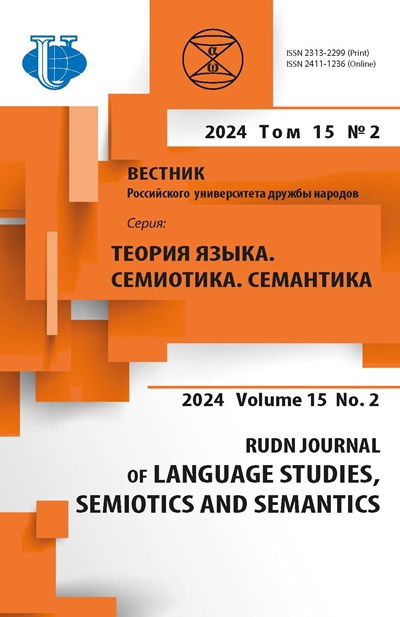ОСОБЕННОСТИ УПОТРЕБЛЕНИЯ РЕАЛЬНЫХ И ВЫМЫШЛЕННЫХ ТОПОНИМОВ В АЗЕРБАЙДЖАНСКИХ И АНГЛИЙСКИХ ХУДОЖЕСТВЕННЫХ ТЕКСТАХ
- Авторы: Ганиева ИЯ1
-
Учреждения:
- Институт языкознания Национальной академии наук Азербайджана
- Выпуск: Том 8, № 3 (2017)
- Страницы: 643-653
- Раздел: Статьи
- URL: https://journals.rudn.ru/semiotics-semantics/article/view/17026
- DOI: https://doi.org/10.22363/2313-2299-2017-8-3-643-653
Цитировать
Полный текст
Аннотация
В данной статье группируются возможности использования топонимов в художественных текстах двух разносистемных языков. Здесь обосновывается тот факт, что писатели относятся индивидуально к реальным топонимам. В азербайджанских и английских художественных текстах реальные названия мест используются по двум причинам. Во-первых, чтобы убедить читателя, что события, происходящие в художественном тексте, реальны, и во-вторых, чтобы показать, что топонимы - наиболее эффективные средства выражения культуры и традиций народа в современный период. Азербайджанские и английские писатели также используют вымышленные топонимы в своих произведениях. В азербайджанской литературе Дж. Мамедкулизаде, а в английской литературе Т. Гарди отдают предпочтение вымышленным топонимам, что характеризует их стиль. Актуальность данной статьи определяется сравнительным анализом стилистических возможностей топонимов на базе конкретного материала двух разносистемных языков (азербайджанского и английского). Цель исследования - определить роль реальных и вымышленных топонимов в рамках художественного текста. Предметом исследования является анализ функционирования топонимов в художественных текстах двух разносистемных языков. Объектом исследования является реальные и вымышленные топонимы, употребляемые азербайджанскими и английскими писателями. В работе применяется комплексная методика исследования, используются такие методы, как дескриптивный, сравнительный, контекстуальный, стилистический, статистический и т.д. Источниками для исследования послужили азербайджанские и английские художественные тексты, а также научная литература по ономастике, стилистике и лексикологии. Результаты работы могут найти применение в чтении спецкурсов, проведении семинарских занятий, написании дипломных и диссертационных работ.
Ключевые слова
Об авторах
И Я Ганиева
Институт языкознания Национальной академии наук Азербайджана
Автор, ответственный за переписку.
Email: radaganiyeva@rambler.ru
Ганиева Ирада Ясиновна, докторант Института языкознания Национальной Академии наук Азербайджана, cтарший преподаватель кафедры иностранных языков Азербайджанского государственного экономического университета. Научные интересы: языки, типология, компаративистика, германистика, теоретическое языкознание.
просп. Г. Джавида, 115, Баку, Азербайджан, 1143Список литературы
- Горбаневский М.В. Ономастика в художественной литературе. Москва: Издательство РУДН, 1988.
- Калинкин В.М. Поэтика онима. Донецк: Юго-Восток, 1999.
- Магазаник Э.Б. Ономастика или «говорящие имена» в литературе. Ташкент: Фан, 1978.
- Arif M. Ədəbi tənqidi məqalələr. Bakı: Azərnəşr, 1993.
- Bağırov Q.Ə. C.Məmmədquluzadənin nəsr və dram əsərlərindəki toponimlər və danışıq dili // Azərbaycan Onomastikası Problemləri (AOP), Bakı: APİ nəşriyyatı, 1987, I, S. 245-247.
- CəfərovA.G. Nəbi Xəzrinin poetik dili. Bakı: Elm və təhsil, 2012.
- Əfəndiyeva T.Ə. Azərbaycan dilinin leksik üslubiyyatı. Bakı: Elm, 1980.
- Əliyeva D.T. M.S.Ordubadinin dili və üslubu // Humanitar elmlərin öyrənilməsinin aktual problemləri. Bakı: Mütərcim, 2010, N 2, S. 10-14.
- Hacıyev T.I. Satira dili: Molla Nəsrəddinin dili. Bakı: ADU, 1975.
- Qurbanov A.M. Azərbaycan onomalogiyası məsələləri. Bakı: APİ, 1986.
- Məmmədquluzadə C. Əsə rləri. 4 cilddə. Ic. Bakı: Öndər Nəşriyyat, 2004.
- Məmmədquluzadə C. Əsərləri. 4 cilddə. IIIc. Bakı: Öndər Nəşriyyat, 2004.
- Fleissner R.F. Names, titles and characters by literary writers: XIX and XX century authors. Lewiston: Edwin Mellen Press, 2001.
- Hardy T. Jude of Obscure. London: Penguin Books, 1985.
- Jerome J.K. Three men in a boat. Oxford: Oxford University Press, 2002.
- Litt D. Names in English renaissance literature. Lewiston: Mellen Press, 2001.
- Map of Thomas Hardy’s Wessex. http://www.bl.uk/collection-items/map-of-thomas-hardyswessex.
- Tales from Shakespeare. Moscow: Prosvesheniye, 1962.













